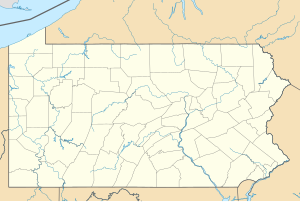Starrucca Viaduct
Coordinates: 41 ° 57 ′ 48 ″ N , 75 ° 35 ′ 0 ″ W.
| Starrucca Viaduct | ||
|---|---|---|
| use | Railway bridge | |
| Crossing of | Starrucca Creek | |
| place | Lanesboro, Pennsylvania | |
| construction | Stone arch bridge | |
| overall length | 317 m | |
| width | 7.9 m | |
| Number of openings | 17th | |
| Longest span | 15.5 m | |
| height | 30.5 m | |
| start of building | 1847 | |
| completion | 1848 | |
| planner | Julius W. Adams, James P. Kirkwood |
|
| location | ||
|
|
||
The Starrucca Viaduct is a railway bridge over the valley of Starrucca Creek above its confluence with the Susquehanna River in the small town of Lanesboro , Pennsylvania.
It stands on the route from Port Jervis, New York, to Binghamton , New York, which in 1848 from the New York and Erie Rail Road for its connection from New York City (more precisely: Piermont on the Hudson River north of New York) to Dunkirk on Lake Erie was built. The Central New York Railroad currently operates freight trains on the route.
It was listed on the list of Historic Civil Engineering Landmarks by the American Society of Civil Engineers in 1973 and has been on the National Register of Historic Places since 1975 .
description
The viaduct is 317 m (1040 ft ) long and 30.5 m (100 ft) high. Its deck beam is 7.9 m (26 ft) wide. The viaduct is entirely of natural stone masonry construction, with the exception of three small retaining walls made of bricks in the partially hollow spandrels and the foundation layers of concrete .
It consists of 17 arches, each 15.5 m (51 ft) apart . The arcs are segment arcs that describe an almost complete semicircle. Between the natural stone is hardly visible that the northern fighter each arc is less than 2 cm higher than the southern. This creates the impression of a long, horizontal structure, although the Starrucca Viaduct has a gradient of 1.1%.
The pillars have a rectangular cross section of 3.45 m × 10 m at the base, which tapers to 2.13 m × 7.62 m at the transom line.
history
The Starrucca Viaduct was built according to the plans and under the supervision of Julius W. Adams and James P. Kirkwood by up to 800 workers in the two construction seasons of 1847 and 1848. The first locomotive crossed the bridge on December 9, 1848.
The viaduct and with it the line were originally single-track and designed as broad gauge. In 1886 they switched to double- track standard gauge , which was possible without structural changes to the viaduct. In 1958 the ballast bed was given a concrete base. Otherwise the viaduct remains largely unchanged to this day. However, the line is currently only used on a single track; the second track has been removed.
The heaviest locomotive that regularly drove over them was a mallet triplex locomotive weighing 383 t (422 tons ).
Web links
Individual evidence
- ↑ Starrucca Viaduct on the ASCE website
- ↑ NRIS Number: 75001665
- ↑ The information in this article is based on Erie Railway, Delaware Division, Bridge 189.46 in Historic American Engineering Record (HAER), No. PA-6

